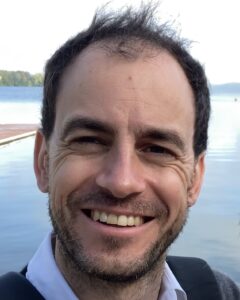
This fall, condensed matter theorist Elio König returned to Madison as an assistant professor of physics. König began his education in Germany and Italy, earning a PhD from the Karlsruhe Institute of Technology in 2014. He joined UW–Madison physics as a postdoc with Alex Levchenko, then completed a second postdoc at Rutgers University. Most recently, König held a group leader position at the Max Planck Institute of Solid State Research in Stuttgart, Germany.
Please give an overview of your research.
I’m a condensed matter theorist, so I study the collective behavior of quantum particles in materials. We study electronic collective behavior — behavior of electronic systems — and I study strong correlations in that regard. We do all of this with an eye on what’s happening in the quantum computation world. Our study of quantum materials can serve as a source of inspiration for building useful quantum devices in the context of quantum computers and potentially beyond.
And then reversely, the advances in quantum technology are of great use in our studying of quantum materials. We can use them as new probes, as new experimental techniques, and at the same time there is theoretical and conceptual cross-pollination. I’m inspired by these synergies.
What are one or two main projects your group will work on first?
The main directions that I’m heading in right now are 2D materials and trying to work more into concepts related to or at the interface between quantum materials and quantum information.
In the 2D world, what I’m really fascinated by is frustrated magnetism in these 2D materials, and in particular research on quantum spin liquids. Generally, the idea is to study states of matter beyond the standard concept of spontaneous symmetry breaking. We’re interested in topologically ordered states and quantum order, which is essentially based on the entanglement of many, many particles together. And these states of matter are relevant for topological quantum error correction codes. I think there’s also quite a lot of interest at UW already, both theoretically but also particularly experimentally, in 2D materials and I hope to collaborate with my future colleagues in that regard.
On the side of quantum materials and quantum information theory, there are ongoing projects that I want to extend on. I want to look for new setups for very robust quantum computers and topological quantum computation. At the same time, I want to use devices which are available right now for emulation of quantum many body systems.
What attracted you to Madison and the university?
This question is related to the question: why am I coming back to the States? I very much enjoyed my five years in the States, personally but also scientifically. The main aspect that I find more present in the States than in Europe is a more visionary approach to science. And I think this is also true for UW, so this is something that attracted me to UW. I know the department maybe better than other new faculty and it’s a fantastic place to work. I know that there are very inspiring colleagues, and I hope that there will be a chance to collaborate with them. And finally, Madison is a very nice place to live. I think it’s probably the nicest city of this size that I’ve seen in the States.
What is your favorite element and or elementary particle? [editor’s note: this interview was conducted via Zoom while König was on a cycling trip through the Italian Alps]
I read some previous interviews, so I knew this question was coming. And when I was biking today, I was thinking about it. Given that I’m mountain biking in the Alps and it’s really intense, I decided that oxygen is the element I want to go for. I can’t get enough of it right now. Oxygen is of course a symbol for the life that humans and animals have on this planet. Finally, oxygen is also a symbol for the advances of science and scientific revolutions, for example Lavoisier’s pioneering work in this regard.
What hobbies and interests do you have?
I really enjoy biking — mountain biking and gravel biking in particular. This is the third time that I’m transversing the Alps. I got very much into dancing in the last three years in Stuttgart. I still dance forró, or Brazilian couple dancing, from time to time. I also like playing sports, particularly soccer and squash.

